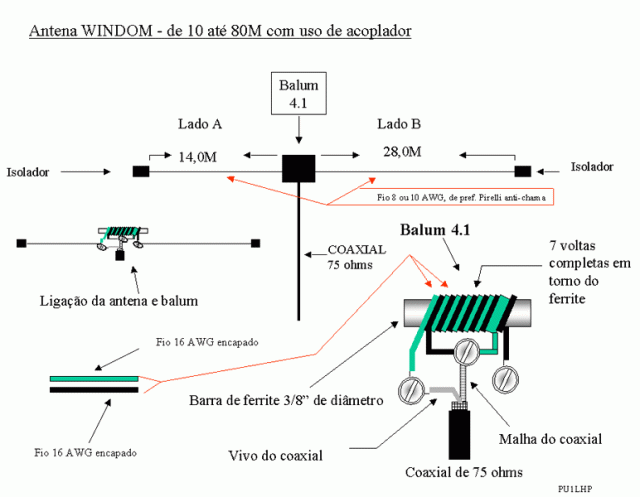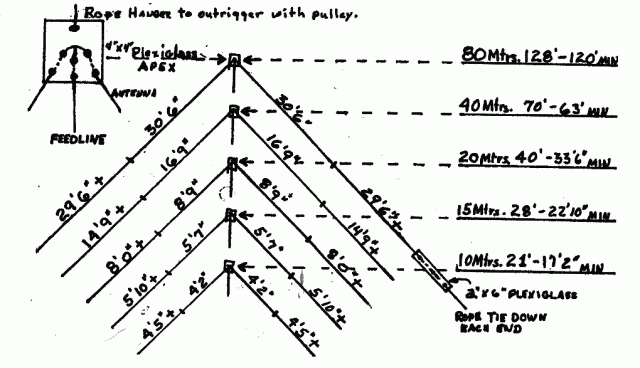 Another antenna added from the antenna plan is a 160 meter ¼ wavelength inverted L.
Another antenna added from the antenna plan is a 160 meter ¼ wavelength inverted L.
A 130 foot length of 12 gauge PVC covered stranded wire slopes up from the ground system to the 40 foot level of the 45 foot tall fiberglass flagpole (about 60 feet of wire length) and then proceeds about 70 feet toward the far back edge of my property. The 90 foot start-to-finish dimension just fits my city lot. At the end, the antenna wire is terminated at about 15 feet above the level of the back yard. The geometry actually resembles an inverted L that has partially fallen over – in other words, a “lazy L”. This antenna is used on 160 meters only and is coaxial cable fed.

In place of an active tuner, a 10 turn 4 inch diameter tapped coil wound of 0.250 inch diameter copper wire is used to tune the 1.8 to 2.0 MHz band in three segments.
Two vacuum relays are used to select the correct amount of the coil for a particular band segment. No coil turns are added to the top band segment, 7 turns are connected in series for the middle tuning range and the entire coil is used at the bottom end of the band. All of the base load components plus the static discharge arrestor are located in a 7 inch square weatherproof box that is bolted to the ground structure.
The coaxial cable entry point is sealed with silicone sealant to keep the spiders and moisture out. The wire that brings power to the relays is TV rotor cable which is rated to be used outside in the weather.

The transient suppressor and coaxial cable braid bus-work is bonded to the ground system with a heavy braid.

The cross-section of the metal drainage ditch that is used as the ground system for this antenna is shown below.

This metal drainage ditch is about 100 feet long and runs along the top of a five foot high concrete block wall that defines the eastern boundary of my city lot. The drainage ditch measures 12 inches wide and 12 inches deep. All of the 10 foot long metal sections are electrically bonded together along the length. This provides a very good earth ground for this 160 meter 1/4 wave inverted L antenna as well as a reflector / ground reference for the 75/60/40 meter NVIS antenna that is mounted directly above the metal ditch (see the NVIS page for more details about this antenna).
An improvement that I am considering for the ground system is to add a couple of wire radials in addition to the drainage ditch ground system. These radials will be run underground by fishing them through the drainage pipes buried under my driveway and front lawn. I think I’ll connect them with a remotely controlled relay so that I can more easily quantify their usefulness during actual on air contacts.
Another improvement under consideration is to add a number of 10 foot long ground rods along the length of the metal drainage ditch, especially near to the antenna feed point.
Since my back of the envelope calculations indicate that this antenna is only about 35% efficient (at best), these combined improvements could potentially yield as much as another 1 to 2 db of signal strength at the receiving end of my transmitted signal. Very interesting??
![]()
The antenna wire coming from the weatherproof box mounted on the metal drainage channel (lower center of the photo) first goes up to the top of the brown painted PVC pole (at the upper right of the photo),

From there it proceeds up to a point about five feet from the top of the 45 foot tall fiberglass flag pole. This places the 160 meter antenna five feet below and at about 30 degrees crosswise to the OCF Windom antenna wire to minimize interaction between the two antennas.

The far end of the antenna is attached to t he fence with a pulley and one gallon paint pail counter weight that takes the sag out of the antenna wire and allows the antenna pole to sway freely with the wind without stretching or breaking the antenna wire.

The maximum SWR at the edges of each of the three segments is less than 2.5:1. At 1.945, the frequency that I use the most, the Rs measures 33 ohms with an Xs of 32 ohms for an SWR of about 1.9:1 according to my MFJ-269 analyzer.
Since the static discharge protection is located at the base of the antenna, the coaxial feed line goes directly to the shack through a 100 foot length of coaxial cable. The antenna loads nicely and shows virtually no change in SWR when operating in either dry conditions or on a rainy day.
The antenna handbooks show that the inverted L has a more or less omni directional pattern that is uniform within about 1.5 db. The signal reports from any direction using this antenna are always as good as or better than the signal reports for other hams using top loaded verticals, full wave loops and dipoles at similar heights. This antenna is not a multi-element full size vertical array using massive towers, but it does work and works quite well. This is the one band where I often run the full power in order to overcome the very noisy band conditions that are typical at the receiving end.
160 meters is also the band where the 38 inch diameter magnetic loop antenna (pictured at the left) really shines. This loop often delivers the best quality receiving signal, especially if there are plasm TVs operating in the vicinity (see the PIXEL loop page for more details about the performance of this loop on the 160 meter band).
Article by W6SDO originally available at http://www.w6sdo.com:80/160M.html


 The recently updated
The recently updated 
 This 2m yagi uses design data from DK72B’s excellent yagi website. The element to boom mounting used here may be of use to some as it does not use any polamid mounting / insulating clamps at a cost of 2 euro each ( this is a 7 el crossed Yagi so twelve clamps would be needed ).
This 2m yagi uses design data from DK72B’s excellent yagi website. The element to boom mounting used here may be of use to some as it does not use any polamid mounting / insulating clamps at a cost of 2 euro each ( this is a 7 el crossed Yagi so twelve clamps would be needed ).
 With the rally season upon us, it is an ideal time to pick up those bits and pieces with which to experiment. The antenna described here consists of a 50R coax fed, inductor loaded 5.44m vertical section mounted on a 1m alloy tube driven into the ground and requires no radials although this may well depend on the local soil structure.
With the rally season upon us, it is an ideal time to pick up those bits and pieces with which to experiment. The antenna described here consists of a 50R coax fed, inductor loaded 5.44m vertical section mounted on a 1m alloy tube driven into the ground and requires no radials although this may well depend on the local soil structure.